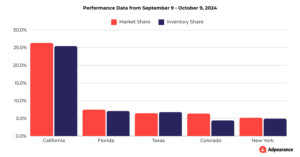Who’s buying electric vehicles?
The Environmental Protection Agency issued regulations on the supply of electric vehicles (EVs) and plug-in hybrid electric vehicles (PHEVs) this spring, causing a stir among U.S. auto dealers. And although the requirements have since been revised, the current target — to reach 35-56% of new vehicles sold by 2032 — is still ambitious.
Bottom line: dealers have to be prepared to sell electric vehicles.
Auto dealers are gearing up to sell EV inventory that, in many markets, exceeds consumer demand. So, who’s buying EVs anyway, and what do dealers need to understand to move this inventory effectively?
Rick Wainschel, Vice President of Data Science and Analytics at Adpearance’s sister company, Cloud Theory, says customers who are ready to buy an EV might fall into a number of descriptive categories influenced by overlapping demographic and behavioral factors.
Customers more likely to purchase electric vehicles may have:
- Ability to pay higher prices. EV buyers can afford to pay a premium for electric vehicles, which cost more than their traditional gas-engine counterparts. For example, October 2024 data shows the market price of a new Chevy Equinox EV is $45.4K compared to $34.1K for a gas-engine Equinox. Similarly, a new Ford F-150 costs $56.8K for gas and jumps up to $64.1K for hybrid or $71.4K for electric.
- More access to infrastructure. EV purchasers can charge up at home, and they have charging stations available in their communities and at their frequented destinations.
- Consistent driving and commuting habits. A daily commuter who lives 20 miles from their workplace and doesn’t have to plug in until they get back home is more likely to purchase an EV than someone with a variable schedule or longer distances to job sites.
- Predictable travel patterns. It takes four minutes to fill up a gas tank, but 30 minutes to fully charge an electric vehicle battery. People who purchase EVs travel in ways that allow them to take longer breaks between legs of a trip.
- Another means of transportation. Given the advance planning and infrastructure EVs require, it’s no surprise that many people buying EVs have a second car or other resources that let them maintain greater flexibility than other customers.
- An “early adopter” mindset. Buying an EV requires a higher level of comfort with new technology and trust in its innovators.
- An eco-conscious mindset. People who purchase EVs may believe they’re doing something good for the planet. Case in point: California, where voters support more stringent environmental protections, is by far the biggest state in terms of EV movement.

All these factors converge on top of a regulatory backdrop that’s still evolving — leaving dealers with a lot of unknowns. “There’s a ceiling on the current level of interest that’s able to occur in the marketplace, and that requires some creativity on the part of dealers,” Rick says.
How to keep up with changing data
Mindsets and popular opinion can shift. Supply could increase or decrease with regulation changes. PHEVs may or may not be included in future EV market share targets. And the 2024 presidential election will be extraordinarily impactful on the regulatory picture.
“People don’t know what to expect,” Rick says. “It’s a regulatory whipsaw; you have to be ready for more regulation or less, and that makes it very hard to plan.”
Adpearance uses MarketAI, a digital marketing tool powered by machine learning, to scrape, track and interpret automotive market and inventory data. We then use this information to help auto dealers compete in their markets, informed by their own inventory data.
The more increased EV production is required of OEMs, the more dealers face intensifying pressure to move this electric vehicle inventory, and MarketAI offers dealers three major advantages: Real-time data; the ability to filter that data; and he ability to inject your own knowledge to customize data insights for your organization.
Increase EV turn rate with digital marketing technology
Here are three ways Adpearance uses MarketAI to help dealers collect, refine and apply market data to impact their EV sales:
- Get real-time intelligence for your competitive context. Our tech scans 19,000 dealer inventories* — an impossible amount of data for a human to keep up with. Having visibility into what’s actually happening right now is indispensable, especially in a climate where anything can change. When inventory numbers are influenced by shifting policy or sentiment, MarketAI’s dealer dashboard reflects these adjustments immediately.
- Add your perspective on top of the data. Dealers often have intelligence the data doesn’t yet reflect. If something’s on the horizon — say, a parts shortage that will impact inventory — you can layer your knowledge on top of the data to gain a more accurate picture. “We can create an overlay of business reality and business strategy,” Rick says. “We can draw boxes around the data or not and make it as wide or as focused as you need it or want it to be.”
- Customize insights to focus on sitting inventory. One tricky aspect of audience algorithms used in marketing — namely, those developed by Meta and Google — is that they can create self-fulfilling prophecies. The more people see and respond to something they like, the more it gets put in front of them. This can give a sense of higher demand but might not actually translate to selling vehicles — because, as Rick says, “You can react positively to a Ford Mustang even if you’re ultimately going to buy an Escape.”
It can also waste marketing resources on vehicles you don’t really need help selling. By factoring in your own inventory data, MarketAI helps you make marketing and advertising decisions to move the cars you need to sell — not what’s already getting the most attention. “Dealers can control this equation in a way Meta never can, because Meta doesn’t know which vehicles are having the most trouble selling,” Rick explains. “Ultimately, MarketAI isn’t replacing your smarts — it’s seeing how the technology can supplement your smarts.”
See your dealership’s data in action
Want to see how MarketAI technology can help you develop a strong EV marketing strategy, complete with introductory insights based on your data and unique to your dealership? Make it happen today: Book a free digital analysis with an Adpearance expert.
*This number is based on OEMs with dealer websites. As such, it does not include Tesla and Rivian inventory data.
The post Who’s buying electric vehicles? appeared first on Adpearance.


